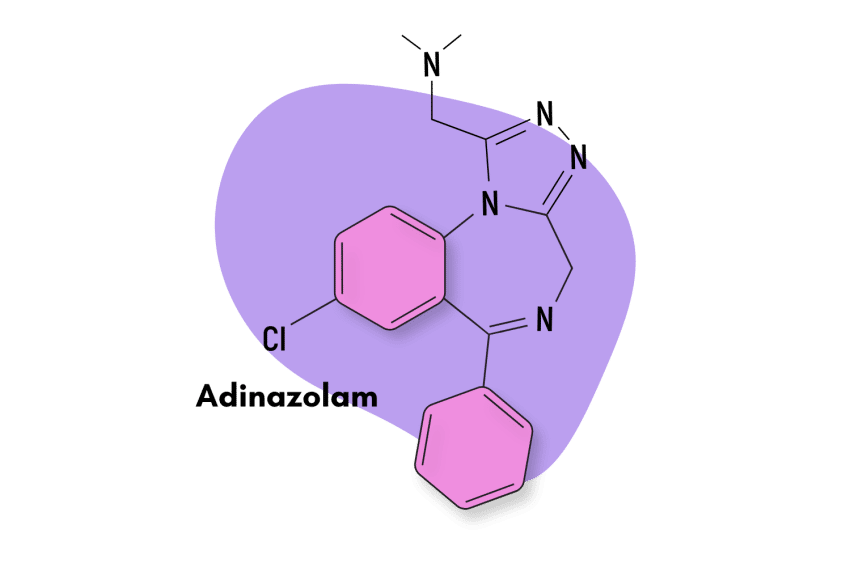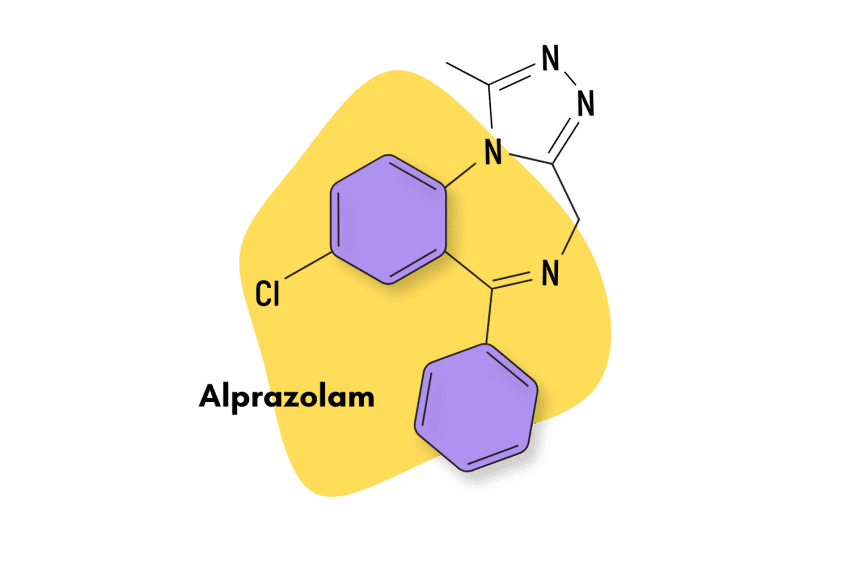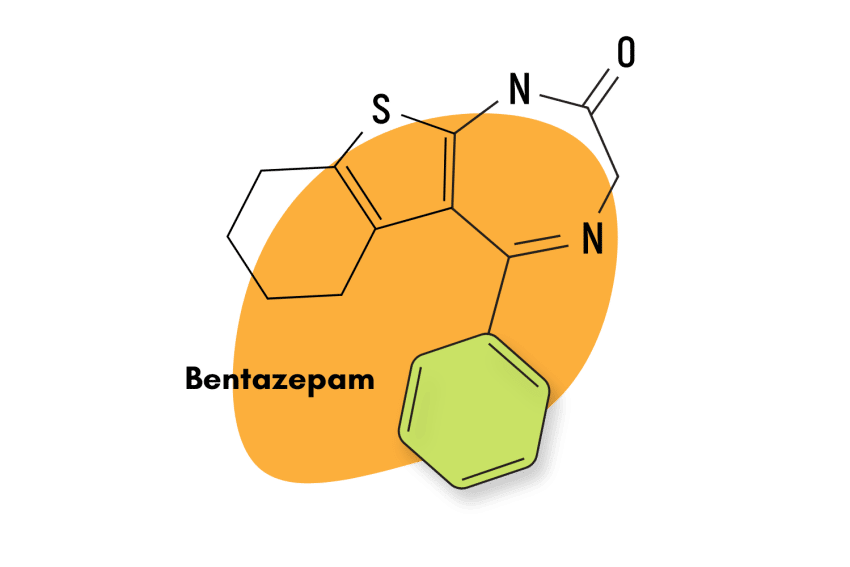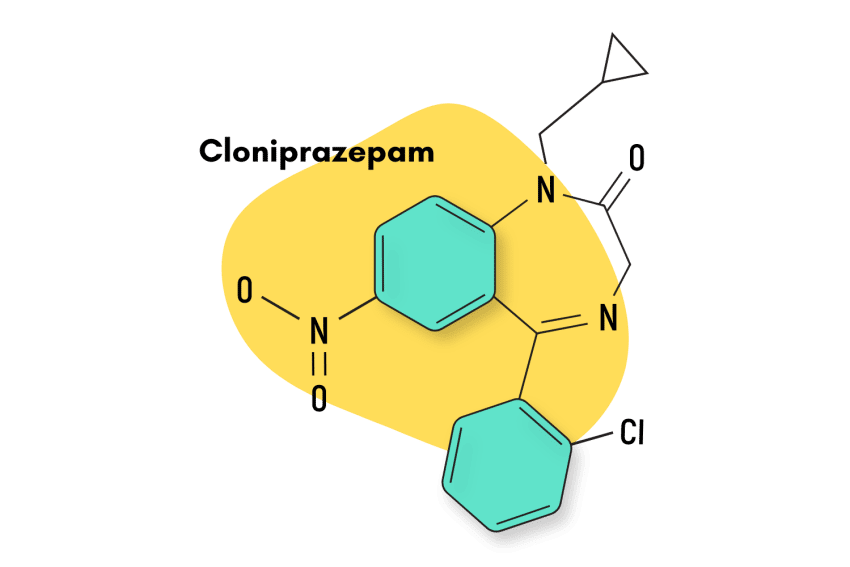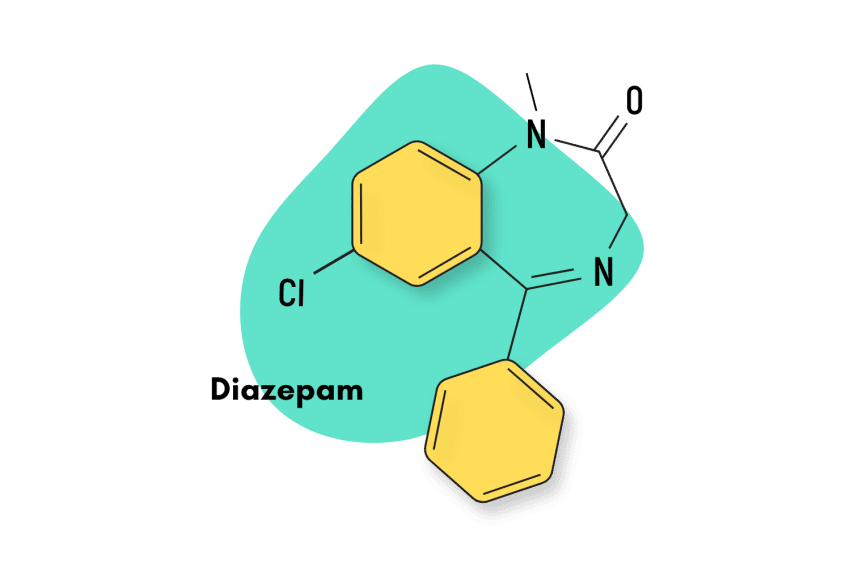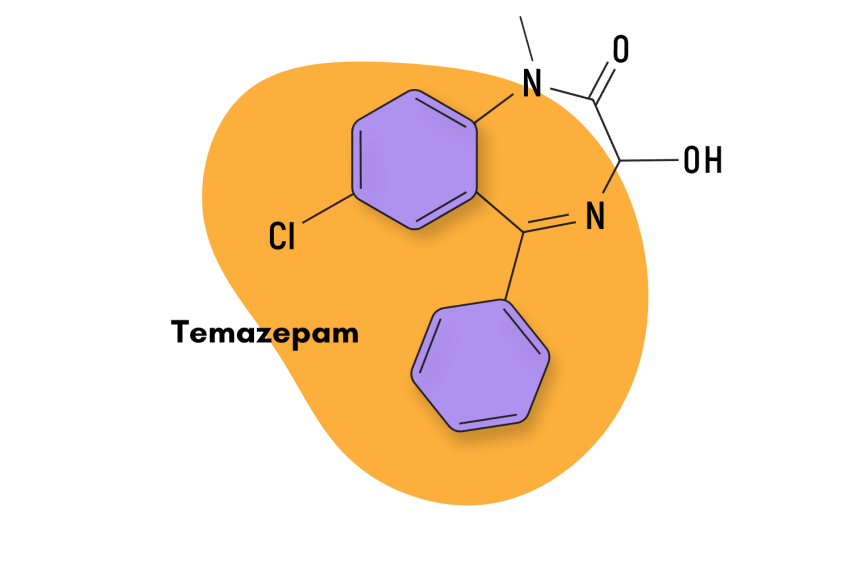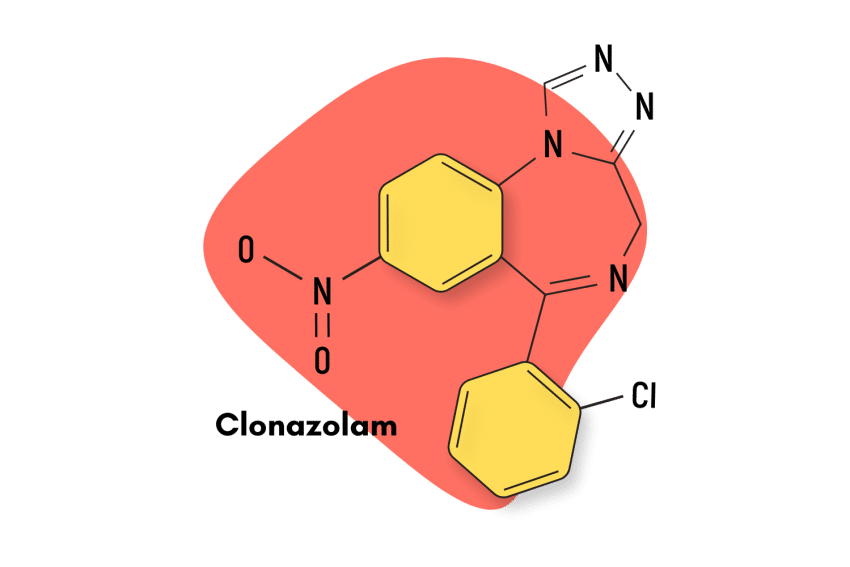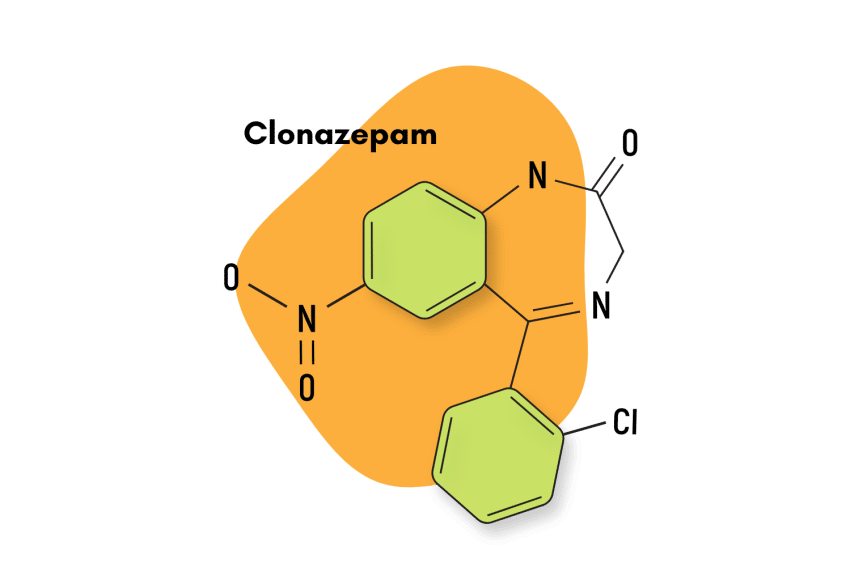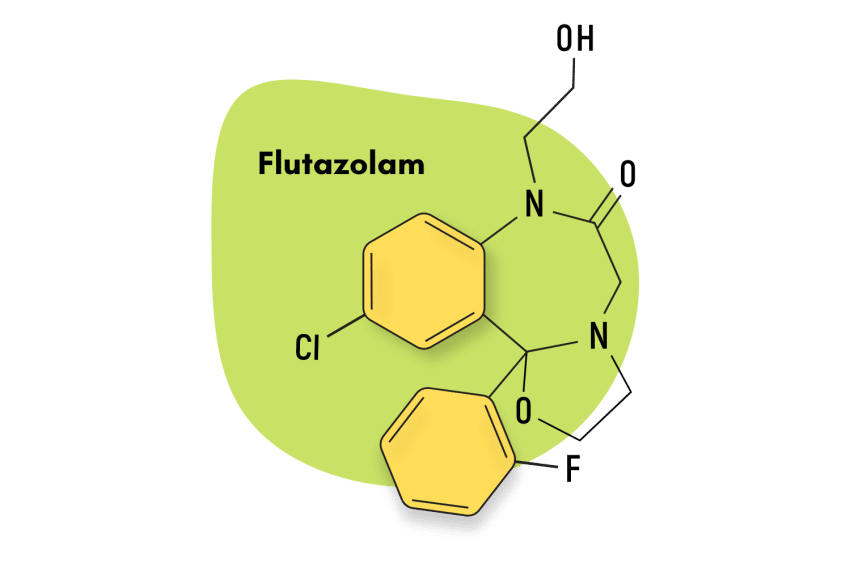Metizolam Fact Sheet & Harm Reduction Tips
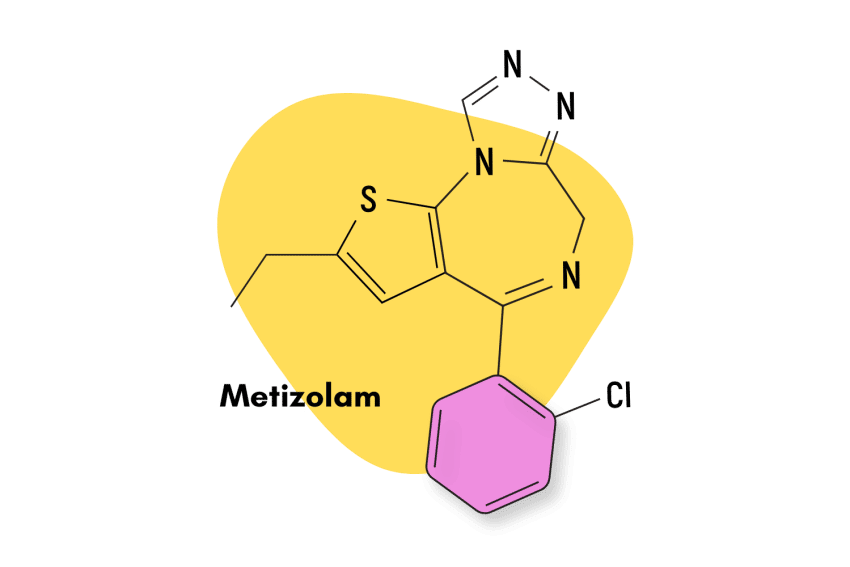
Metizolam is an obscure benzodiazepine drug and a metabolic byproduct of etizolam that’s been gaining popularity around Europe in the past couple of years.
Metizolam was first detected in Germany as a light blue-colored round-shaped tablet by the Institute of Forensic Medicine at the University of Freiburg in September 2015. Then, Danish customs identified the compound in October, which was sent from the UK [2].
In 1995, metizolam was patented by a Japanese company for treating anxiety [3]. However, it was never brought to market. It’s considered a research chemical with very little data on human usage.
The United Nations Convention on Psychotropic Substances and the 1961 Single Convention on Narcotic Drugs don’t currently control this drug [2].
In different studies, metizolam has shown physical effects like sedation, hypnosis, and muscle relaxation, as well as cognitive effects like anxiolysis, disinhibition, euphoria, and amnesia [4]. Although it structurally resembles another drug, etizolam, metizolam is only about half as potent.
Metizolam Specs
| Status | Research chemical |
| Common Dosage | 2-4 mg |
| PubChem ID | 12434325 |
| CAS# | 40054-68-0 |
IUPAC Name: 7-(2-chlorophenyl)-4-ethyl-3-thia-1,8,11,12-tetrazatricyclo[8.3.0.02,6]trideca-2(6),4,7,10,12-pentaene
Other Names: Desmethyletizolam, 40054-68-0, UNII-K1C6XI9LLX, K1C6XI9LLX
Metabolism
The metabolism of Metizolam is primarily an oxidative process in the liver moderated by the CYP450 enzyme family, particularly by CYP3A4 [2].
Duration of Effects
Short-acting (5-8 hours). The half-life of metizolam ranges between 2 to 6 hours. Onset is within 30–90 minutes, and after-effects may last for 10–30 hours. Peak concentration is achieved between 30 minutes to 2 hours.

What is the Dose of Metizolam?
The light dose of Metizolam is 1 to 2 mg, and the standard dose is 2 to 4 mg. A dose of 4 to 6 mg is considered strong, and anything over 6 mg is a heavy dose.
Metizolam Dosage Equivalency
**Caution:** Benzodiazepines have a narrow therapeutic window. Dose equivalents may not be accurate in higher doses.
This calculator does not substitute for clinical experience and is meant to serve only as a reference for determining oral benzodiazepine equivalence.
Please consult a medical practitioner before taking benzodiazepines.
How Does Metizolam Work?
Metizolam works by boosting the effects of GABA, the body’s premier inhibitory messenger. Benzodiazepines increase the sensitivity to GABA, which blocks electrical transmission and slows brain function.
This inhibition results in the characteristic effects of benzodiazepine drugs, including reduced cognition, reversal of anxiety, muscle relaxation, and sedation (in higher doses).
More specifically, the primary target of benzodiazepines, including metizolam, is the γ-aminobutyric acid type A (GABA-A) receptor situated both in the pre and post-synaptic terminal of neurons [5]. The primary mechanism by which these GABA channels work is through a ligand-gated ion channel. When these ligand-gated ion channels are activated, hyperpolarization of the membrane occurs, and the net result is inhibition of neurotransmission. GABA is one of the main inhibitory neurotransmitters in the body [4].
The GABA receptor is not a single molecule but a complex that is constituted by five protein subunits and is found in a large and widespread manner in the nervous system. These subunits are 2 α subunits, 2 β subunits and 1 γ subunit. Each of these subunits further has different isoforms.
The binding site of the benzodiazepines is located in a space between the α and γ subunits [6]. The conversion into electrical signals from chemical signals by the GABA-A receptors occurs in a fraction of a millisecond [7]. This binding causes a conformational change in the GABA-A receptor, and subsequent action follows.
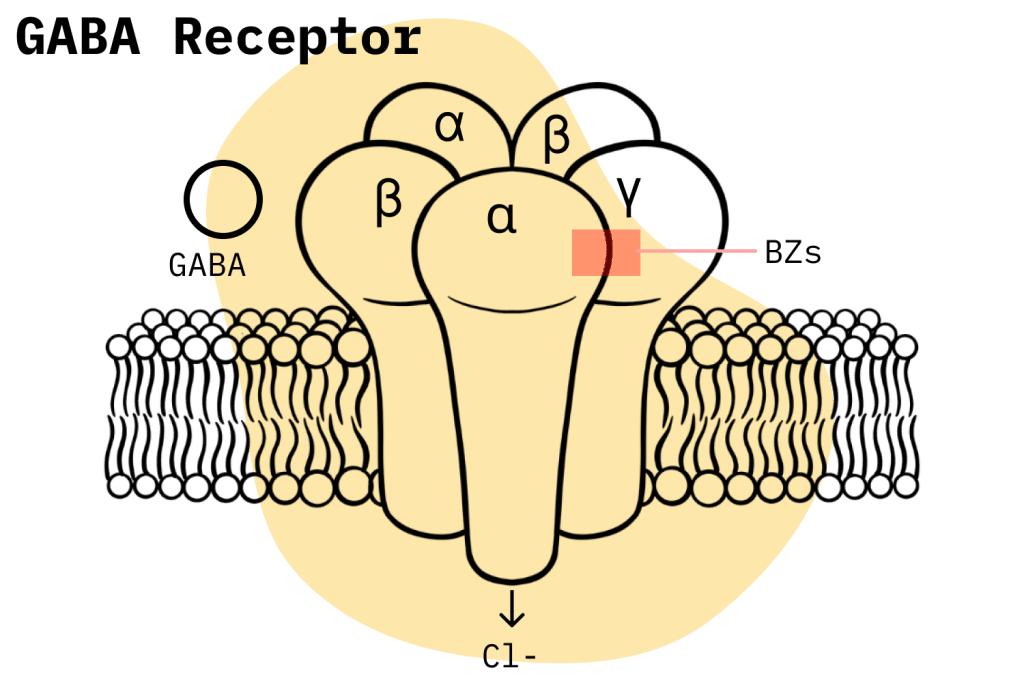
Different benzodiazepines exert different actions because the difference in just one subtype can change the characteristics, like potency, by a significant amount. This is why even structurally similar compounds can be vastly different.
GABA-A receptors provide very quick inhibition in the entire basal ganglia network. By binding to different subtypes of GABA-A, a benzodiazepine like Metizolam can produce different physical and cognitive effects [7].
Is Metizolam Safe? Risks & Side Effects
Metizolam is less potent than many other benzodiazepines but also carries fewer side effects [4].
This drug is not well studied, but the current evidence suggests its relatively safe when used responsibly.
However, the problem with metizolam is that it has a very short duration of action, similar to that of alprazolam (Xanax). This means users must repeatedly take new doses every few hours to maintain the effects. This repeated dosing significantly increases the risk of habit formation and drug dependence.
There’s also a significant risk involved with mixing metizolam with other central nervous system depressants (such as GHB, alcohol, barbiturates, phenibut, or opiates).
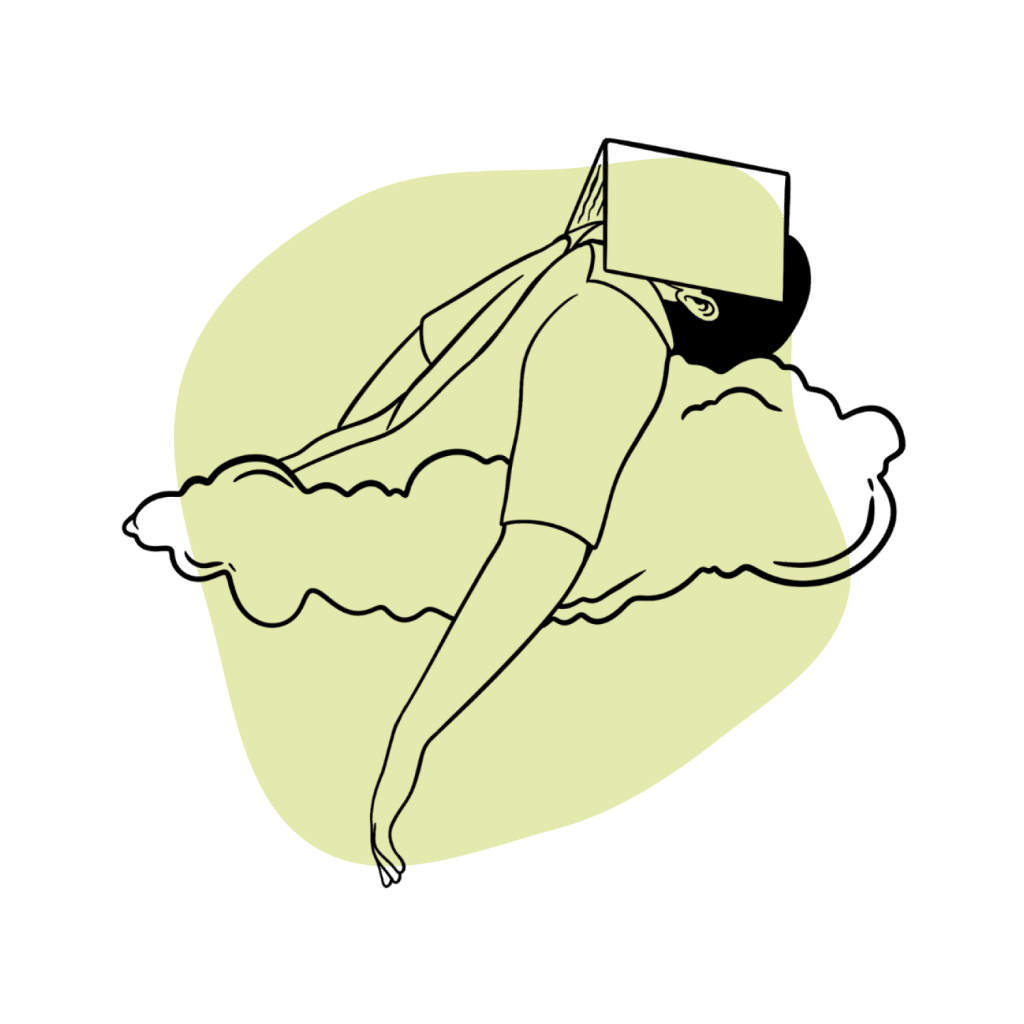
Common Side Effects Of Metizolam
Like most drugs, some side effects are to be expected.
However, make sure to visit your doctor should you experience any of the following:
- Bleeding from the nose or gums
- Breathing difficulty
- Cognition and memory problems
- Confusion
- Feeling dizzy or drowsy
- Firm belief in something that is not real (delusion)
- Gait problems and instability
- Increase in frequency of micturition
- Increase in salivation
- Jaundice
- Memory loss
- Muscle weakness
- Perceiving things that aren’t there (hallucinations)
- Problems with vision, like blurring
- Reduced sex drive
- Signs of anaphylaxis
- Suicidal thoughts
Harm Reduction: Metizolam
The main point of harm reduction for metizolam is avoiding dependence and addiction. This drug requires frequent dosing, which carries a high risk of leading to abuse.
Because metizolam isn’t an approved medication, the only source is illegal black market vendors. This carries a high risk of adulteration or contamination with other potentially dangerous compounds.
Benzodiazepine Harm Reduction Tips:
- 🥣 Don’t mix — Mixing benzodiazepines with other depressants (alcohol, GHB, phenibut, barbiturates, opiates) can be fatal.
- ⏳ Take frequent breaks or plan for a short treatment span — Benzodiazepines can form dependence quickly, so it’s important to stop using the drug periodically.
- 🥄 Always stick to the proper dose — The dosage of benzos can vary substantially. Some drugs require 20 or 30 mg; others can be fatal in doses as low as 3 mg.
- 💊 Be aware of contraindications — Benzodiazepines are significantly more dangerous in older people or those with certain medical conditions.
- 🧪 Test your drugs — If ordering benzos from unregistered vendors (online or street vendors), order a benzo test kit to ensure your pills contain what you think they do.
- 💉 Never snort or inject benzos — Not only does this provide no advantage, but it’s also extremely dangerous. Benzos should be taken orally.
- 🌧 Recognize the signs of addiction — Early warning signs are feeling like you’re not “yourself” without the drug or hiding your habits from loved ones.
- ⚖️ Understand the laws where you live — In most parts of the world, benzodiazepines are only considered legal if given a prescription by a medical doctor.
- 📞 Know where to go if you need help — Help is available for benzodiazepine addiction; you just have to ask for it. Look up “addiction hotline” for more information where you live. (USA: 1-800-662-4357; Canada: 1-866-585-0445; UK: 0300-999-1212).
Avoid Drug Interactions
This is for not just Metizolam but for any drug that you are taking. Do not mix this drug with any other drug, especially other benzodiazepines, sedatives, antihistamines, or depressants like alcohol, as this can pose serious harm to your health.
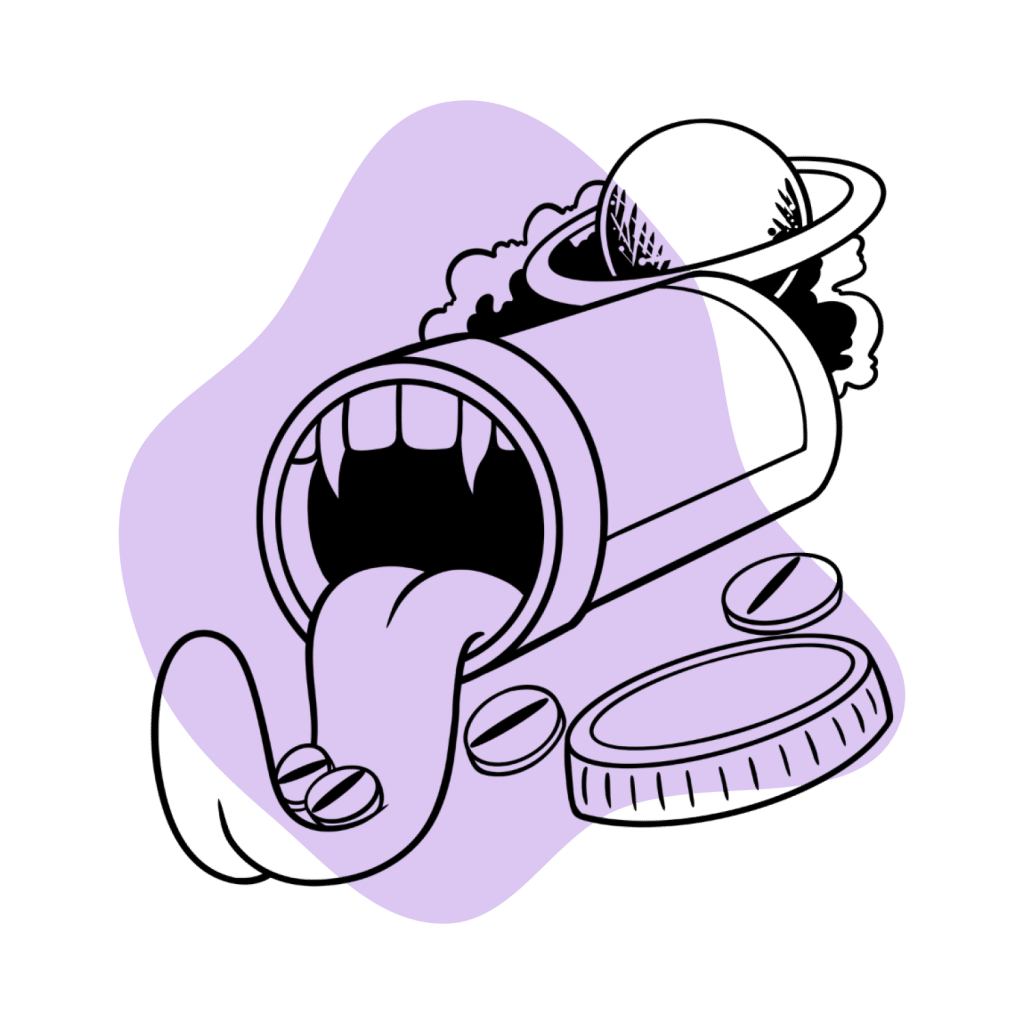
Similar Benzodiazepine Alternatives
Metizolam is considered a short-acting benzodiazepine with relatively low potency compared to other members of the benzodiazepine family.
In terms of duration and effect profile, metizolam is also similar to alprazolam (Xanax) — however, the latter drug is much more potent.
Other compounds with similar effects include bromazepam, etizolam, fluclotizolam, chlordiazepoxide (Librium), and bentazepam.
Metizolam vs. Other Short To Intermediate-Acting Benzodiazepines [8]:
| Metizolam | Etizolam | Fluclotizolam | Deschloroetizolam | Bentazepam | |
| Chemical composition | 1,4-benzodiazepine | 1,4-benzodiazepine | 1,4-benzodiazepine | 1,4-benzodiazepine | 1,4-diazepin-2-one |
| Route of administration | Oral | Oral | Oral | Oral | Oral |
| Onset of action | 30 to 90 minutes | 10 to 40 minutes | 10 to 30 minutes | 1 to 5 minutes | 15 to 45 minutes |
| Duration of effects | Short-acting (5 to 8 hours) | Short-acting (5 to 28 hours) | Short-acting (6 to 14 hours) | Short-acting (8 to 10 hours) | Short-acting (3 to 6 hours) |
| Mechanism of action | GABA-A receptor agonist | GABA-A receptor agonist | GABA-A receptor agonist | GABA-A receptor agonist | GABA-A receptor agonist |
| Medical Uses | Muscle relaxation, sedation | Anxiety disorder, insomnia, treatment of withdrawal symptoms | Sedation, hypnosis | Sedation, muscle relaxation | Anxiety disorder, anti-convulsant, sedative, muscle relaxation |
Natural Alternatives to Benzodiazepines
There are a few plants and nutrients that may serve as alternatives to benzodiazepine drugs like metizolam. None of these plants are going to be as strong as the drug, but they offer similar effect profiles and may provide enough relief to avoid using this addictive class of drug in the first place.
Here are some of the best natural benzo alternatives available.
Kava
The Kava plant (Piper methysticum) is one of the go-to herbs for treating anxiety. A randomized, double-blind study compared kava extract with a placebo for the treatment of anxiety. The study revealed there was a significant reduction in anxiety after taking kava using the Hamilton Anxiety Scale (HAM) [9].
Kava contains a series of active ingredients called kavalactones — several of which work through the same mechanisms as benzodiazepine drugs. These compounds modulate the GABA receptor to enhance the natural inhibitory action of GABA. This results in a feeling of calmness, relaxation, and sedation in higher doses.

Gotu Kola
Gotu kola (Centella asiatica) is a traditional herb used in Chinese medicine and Ayurveda. Several studies show that Gotu kola has anxiolytic effects in humans via the GABA pathway and several other neuroregulatory systems, such as the cholecystokinin (CCK) receptors [10].
Gotu kola doesn’t feel like a benzodiazepine, but it offers similar benefits for anxiety and insomnia.
Valerian
Valerian (Valeriana officinalis) is a popular herbal remedy for sleeplessness. It’s taken in different forms, like extracts, tinctures, or tea from dried roots.
Several active ingredients in valerian target the GABA receptors in a similar capacity to benzodiazepines — albeit to a lesser extent. Many users find valerian a suitable alternative to benzos while trying to quit or as an alternative to avoid using these compounds entirely.
A 2014 study compared the effectiveness of valerian extract with diazepam (Valium) — another popular benzodiazepine [11]. The study concluded that there was no significant difference between the two treatments, suggesting valerian as a viable alternative to benzodiazepine medications.

L-Theanine
L-theanine is one of the active ingredients in green tea (Camellia sinensis). It’s an amino acid isomer that resembles a naturally-occurring neurotransmitter called glutamate. This neurotransmitter has an impressive relaxant and anxiolytic profile and is primarily used for managing anxiety or insomnia.
A systematic review that analyzed L-theanine demonstrated a significant reduction in stress and anxiety among the study participants [12].
St. John’s wort
St. John’s wort (Hypericum perforatum) is one of the premier antidepressant herbs available [13]. Herbalists revere this plant for its unique ability to improve mood and regulate healthy sleep patterns. This herb is not sedative and doesn’t feel like benzodiazepines, but it does have a lot to offer for many of the same conditions these medications treat.
This plant is well-researched, and the mechanism of action was determined to be at least partially the result of St. John’s Wort’s ability to inhibit serotonin reuptake in a similar capacity to conventional SSRI antidepressant medications [16].
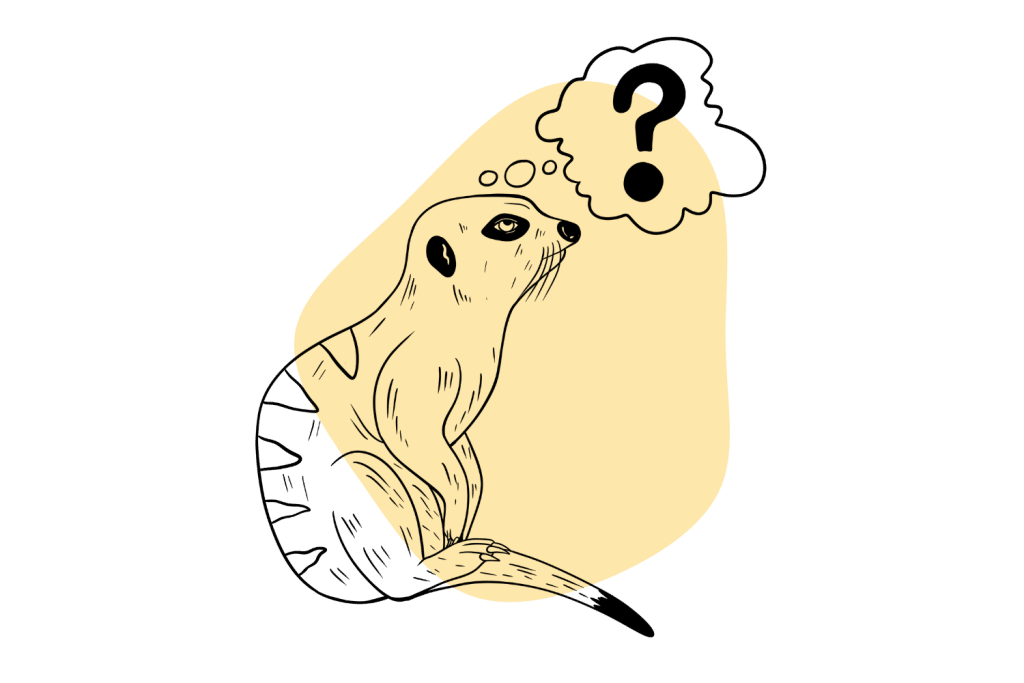
Metizolam FAQs
Can I be prescribed metizolam?
Metizolam was never approved for sale and is not available via prescription. Doctors may prescribe similar medications, such as alprazolam (Xanax) or diazepam (Valium) instead.
How long will it take for metizolam to be legally available?
It is currently unknown if or when Metizolam will be cleared for use in humans. This is because all drugs need to pass through extensive research and phases before they’re rolled out to the public. It does not appear like this drug will ever be brought to market.
Can I mix metizolam with other drugs?
It’s not wise to mix any benzodiazepine with other medications or recreational drugs without consulting a doctor first. Benzos carry an especially high risk of serious side effects when combined with substances such as alcohol, GHB, phenibut, barbiturates, opiates, or other benzodiazepines.
Can I buy metizolam from online vendors?
Metizolam is only available illegally. There are numerous online vendors carrying this drug, but it’s wise to be very cautious about these sources. Credit card theft, drug adulteration, and contamination rates are very high with these illegal sources.
References
- Kintz, P., Richeval, C., Jamey, C., Ameline, A., Allorge, D., Gaulier, J.-M., and Raul, J.-S. (2017) Detection of the designer benzodiazepine Metizolam in urine and preliminary data on its metabolism. Drug Test. Analysis, 9: 1026– 1033.
- Orsolini, L., Corkery, J. M., Chiappini, S., Guirguis, A., Vento, A., De Berardis, D., … & Schifano, F. (2020). ‘New/Designer Benzodiazepines’: an analysis of the literature and psychonauts’ trip reports. Current neuropharmacology, 18(9), 809-837.
- Kintz, P., Richeval, C., Jamey, C., Ameline, A., Allorge, D., Gaulier, J. M., & Raul, J. S. (2017). Detection of the designer benzodiazepine Metizolam in urine and preliminary data on its metabolism. Drug testing and analysis, 9(7), 1026-1033.
- El Balkhi, S., Monchaud, C., Herault, F., Géniaux, H., & Saint-Marcoux, F. (2020). Designer benzodiazepines’ pharmacological effects and potencies: How to find the information. Journal of Psychopharmacology, 34(9), 1021-1029.
- Moosmann, B., & Auwärter, V. (2018). Designer benzodiazepines: another class of new psychoactive substances. In New psychoactive substances (pp. 383-410). Springer, Cham.
- Olsen, R. W., & Sieghart, W. (2008). International Union of Pharmacology. LXX. Subtypes of γ-aminobutyric acid-A receptors: classification on the basis of subunit composition, pharmacology, and function. Update. Pharmacological reviews, 60(3), 243-260.
- Goetz, T., Arslan, A., Wisden, W., & Wulff, P. (2007). GABAA receptors: structure and function in the basal ganglia. Progress in brain research, 160, 21-41.
- Griffin, C. E., Kaye, A. M., Bueno, F. R., & Kaye, A. D. (2013). Benzodiazepine pharmacology and central nervous system–mediated effects. Ochsner Journal, 13(2), 214-223.
- Pittler, M. H., & Ernst, E. (2003). Kava extract versus placebo for treating anxiety. Cochrane Database of Systematic Reviews, (1)
- Bradwejn, J., Zhou, Y., Koszycki, D., & Shlik, J. (2000). A double-blind, placebo-controlled study on the effects of Gotu Kola (Centella asiatica) on acoustic startle response in healthy subjects. Journal of clinical psychopharmacology, 20(6), 680-684.
- Shahinfar, J., Zeraati, H., Masrorniya, M., & Shojaei, S. (2016). Comparison of valerian extract and diazepam on anxiety before orthopedic surgery. Journal of Patient Safety & Quality Improvement, 4(4), 434-440.
- Williams, J. L., Everett, J. M., D’Cunha, N. M., Sergi, D., Georgousopoulou, E. N., Keegan, R. J., … & Naumovski, N. (2020). The effects of green tea amino acid L-theanine consumption on the ability to manage stress and anxiety levels: A systematic review. Plant Foods for Human Nutrition, 75(1), 12-23.
- Lakhan, S. E., & Vieira, K. F. (2010). Nutritional and herbal supplements for anxiety and anxiety-related disorders: systematic review. Nutrition journal, 9(1), 1-14.
- Lakhan, S. E., & Vieira, K. F. (2010). Nutritional and herbal supplements for anxiety and anxiety-related disorders: systematic review. Nutrition journal, 9(1), 1-14.
- Mao, J. J., Li, Q. S., Soeller, I., Rockwell, K., Xie, S. X., & Amsterdam, J. D. (2014). Long-term chamomile therapy of generalized anxiety disorder: A study protocol for a randomized, double-blind, placebo-controlled trial. Journal of clinical trials, 4(5).
- Kasper, S., Gastpar, M., Möller, H. J., Müller, W. E., Volz, H. P., Dienel, A., & Kieser, M. (2010). Better tolerability of St. John’s wort extract WS 5570 compared to treatment with SSRIs: a reanalysis of data from controlled clinical trials in acute major depression. International clinical psychopharmacology, 25(4), 204-213.

